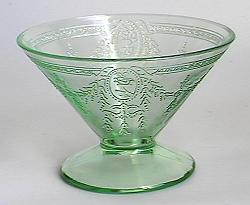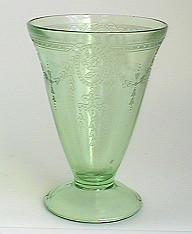
Rose Cameo
Written by Rosemary Trietsch
Many Depression glass patterns feature flowers. There are the realistic representations like Cherry Blossom and Cloverleaf. There are also whimsical florals – like the poppies in Florentine and Tulip, which really has no flowers at all but whose shapes suggest a spring garden. Then there are the patterns that incorporate real flowers and fanciful decorations - Mayfair and Stippled Rose Band blend natural elements with decorative embellishments. Among this last category is a pattern that is often overlooked: Rose Cameo. It’s not a very large pattern and its pedigree was unknown for a while, but Rose Cameo has a grace and beauty that makes it stand out in any Depression glass garden.

When Hazel Marie Weatherman published her first book back in 1969, very little historical documentation had surfaced about Depression glass. After all, it was primarily given away as premiums in soapboxes or flour sacks, and what was sold was marketed as inexpensive dinnerware in dime stores. There seemed to be no need to keep careful records of such inexpensive stuff. (Heck, back in the 1930’s, no one thought it would be around in 20 years, let alone become such a coveted collectible today.) In 1969, Depression glass was only entering the market again because people who had grown up with and been using it for the past 40 years couldn’t stand the sight of it anymore. What little information Hazel was able to uncover for her Guidebook to Colored Glassware of the 1920’s and 1930’s came from the ‘conventional wisdom’ of collectors, and so she listed only those pieces and patterns that she personally seen or had evidence of.
Although much smaller than most of the patterns listed, Rose Cameo was included in this first Depression glass guidebook. Back then, it was considered a great ‘fill in’ or ‘go with’ pattern. Hazel tells us that:
“Probably because of its resemblance to the ‘Cameo’ pattern, this imprint is conventionally called ‘Rose Cameo.’ It comes in green. To date, I have seen a limited number of pieces, but the few I have seen prove useful due to their interchangeability with ‘Cameo’ and other similar patterns.”
She goes on to list 8 pieces available: cup & saucer, 5 inch cereal bowl, sherbet, footed tumbler, and 6 inch, 7 inch and 8 inch plates. (We know today that 4 of these pieces were never produced – cup & saucer, 6 and 8-inch plates.) Like many of the patterns in the book, the manufacturer was unknown and likewise catalogs had not surfaced showing what was pieces were made.
In 1970, when Colored Glassware of the Depression Era came out, an amazing amount of information had surfaced. Hazel had spent the year between her first two books traveling to glass factories, looking through their records and glass morgues, and meeting with factory workers who remembered what was made. Thanks to her legwork, the official name, as well as the company and date of manufacture, for most of our ‘old favorites’ now was known. In many cases, she had uncovered old sales catalogs and was able to provide a somewhat complete list of what pieces were made. But Rose Cameo’s pedigree had eluded her: it remained “of unknown manufacture and date.” She had made some changes to the listing, however, as the 6 and 8-inch plates were no longer included and the 4-½ inch berry bowl and ice tub were added.
It wasn’t until 1973 that the mystery behind Rose Cameo’s origin was solved:
“COPY THIS RIGHT DEPT: It was in the U.S. Patent Office last fall where I got the official poop on this pattern. The copyright was dated Dec. 1, 1931, and signed by its designer, H.A. Lay, who made it for the Belmont Tumbler Company.” (HMW Price Trends, 1973)
Very little is known about the Belmont Glass Company of Bellaire, Ohio as the factory burned down in 1952, taking all the company records with it. The few advertisements that do exist tell us that Belmont specialized in “tumblers in all sizes and desirable shapes for all purposes from one ounce up.” We know they produced glass in crystal, green, pink and iridescent, (though Rose Cameo is only found in green), but we aren’t really sure how much glass they turned out before the Depression forced the factory to close. In fact, many of Belmont’s items were originally attributed to Hazel Atlas, and some folks still believe that Hazel Atlas made Rose Cameo as shards of the pattern have been found at an old Hazel Atlas factory location. Perhaps Belmont commissioned Hazel Atlas to produce some Rose Cameo as a last, desperate attempt to recover some funds and avoid closing. It’s not so improbable when you consider that Bellaire, Ohio is only 4 miles from Wheeling, West Virginia, the home of Hazel Atlas’ main offices. Makes you wonder, doesn’t it?

The mystery surrounding Rose Cameo’s pedigree is not nearly as frustrating as the mystery of why there were only 6 different pieces produced. It’s hard to figure out what Belmont had in mind when they produced it. There is a 7-inch plate, a footed sherbet, a footed tumbler and a 4-½ inch berry bowl. These would suggest a luncheon or desert set. But there is no cup and saucer in the pattern. (In 1976, Hazel removed the cup & saucer, as well as the ice tub from the Price Trends listing.) Instead, Belmont made a 5-inch ‘cereal’ bowl and a 6-inch bowl with straight sides. (This straight-sided bowl was added to the Price trends listing in 1983 and may have been the ice tub that Hazel previously removed.) The ‘cereal’ bowl suggests a breakfast set but, again, with no cup and saucer that doesn’t make sense. It may be that Belmont was experimenting with different shaped bowls to find one that suited the pattern best. The 4 ½ and 5-inch size could just be mold variations: they are basically the same shape but the 4 ½ inch size has a ¼ inch base/foot that’s missing on the 5 inch size. (Mold variation exists with the tumbler- one has straighter sides, while the other has more of a flared rim- so why not the bowls?) The straight-sided bowl has a flat bottom that fits very nicely into the center area of the plate. Perhaps Belmont decided this shape was the best suited to Rose Cameo and planned to discontinue the other two.
Unfortunately we’ll never know for sure what Belmont intended as the Depression prematurely ended their production and the fire of 1952 destroyed their records. Had they been around a few years longer, Belmont might have produced complete dinnerware services instead of only 6 pieces. (Then again, if they had sold the molds to Hazel Atlas, we might have more of these 6 to use and enjoy today. Wishful thinking, I know….) However you decide to use Rose Cameo, your setting will take quite a bit of searching to assemble, as there’s not much around. Collectors have resigned themselves to using it to accent their table, sort of like the Baby’s Breath in a rose bouquet. With its simple lines and graceful shapes, Rose Cameo makes a beautiful addition to any Depression glass garden.
Sources:
Hazel Marie Weatherman: Guidebook to the 1920’s and 1930’s, 1969
Colored Glassware of the Depression Era, 1970
Colored Glassware of the Depression Era, Book 2, 1974
Price
Trends 1973, 1976, 1983